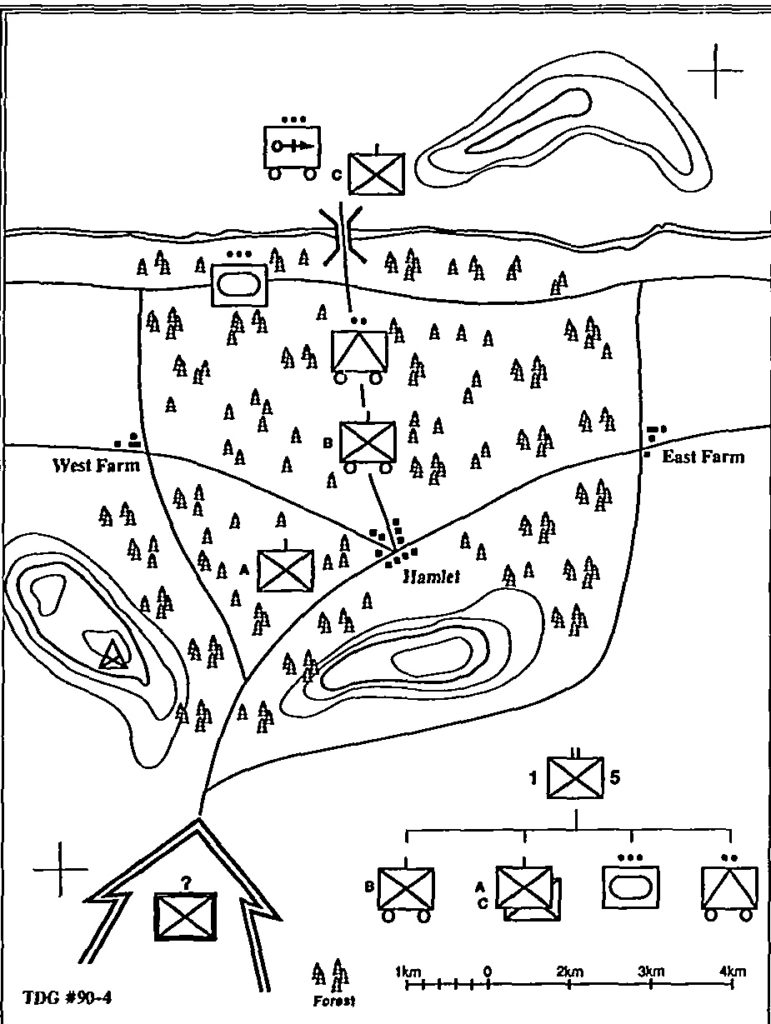Gap at the bridge
Posted on May 13,2019Article Date Jul 01, 1990
by Capt John F. Schmitt
Knowing your enemy means, understanding his capabilities and general intentions. But it also means seeing things the way he sees them, thinking the way he thinks, with the aim of anticipating his actions and thereby gaining the upper hand.
This tactical decision game may look familiar to some readers. It is, in fact, TDG 90-1, “The Enemy Over the Bridge,” with one very significant difference: This time you are the enemy. How will knowing how you reacted to “The Enemy Over the Bridge” influence your actions now that the shoe is on the other foot?
The Situation
 You are the commanding officer, 1st Battalion, 5th Marines. The division is halted temporarily, but the division commander plans to resume the offensive toward the south as soon as logistics can be brought forward. You have been operating north of the river against enemy reconnaissance and security elements. The enemy holds the riverline and the bridge in strength. (You believe the river to be unfordable.) Intelligence indicates that the enemy is planning an imminent offensive north across the river-sooner than your division can be ready to attack in strength. Your mission, which gives you broad latitude in the manner of execution, is to take whatever actions you can to disrupt the enemy attack in your sector.
You are the commanding officer, 1st Battalion, 5th Marines. The division is halted temporarily, but the division commander plans to resume the offensive toward the south as soon as logistics can be brought forward. You have been operating north of the river against enemy reconnaissance and security elements. The enemy holds the riverline and the bridge in strength. (You believe the river to be unfordable.) Intelligence indicates that the enemy is planning an imminent offensive north across the river-sooner than your division can be ready to attack in strength. Your mission, which gives you broad latitude in the manner of execution, is to take whatever actions you can to disrupt the enemy attack in your sector.
A reconnaissance patrol by one of your companies discovers that the enemy forces that were holding the bridge have withdrawn. The company commander has already begun to infiltrate his company across the bridge. You decide to exploit the situation by getting your entire battalion south of the river with an eye toward mounting a spoiling attack. In the process, one of your companies has an engagement near the bridge with an enemy scout car, which flees west on the river road. You contact regiment and explain the actions you have set in motion. The colonel tells you he will reinforce with all the forces he can muster-infantry and tanks will begin to arrive in two to three hours. You have the priority of fires for all supporting arms, he tells you.
The time is about 2000; darkness is descending. Elements of your surveillance and target acquisition (STA) platoon report that Hamlet shows no signs of enemy activity. As your leading companies move into the triangular wood west of Hamlet, another STA team located on the high ground south of the wood reports an enemy column approaching from the south headed toward your position. The STA team sends the following report:
Enemy force, estimate at least battalion strength, moving north on Hamlet road, at the intersection south of the pass; covered tracks, jeeps, infantry on foot; I can hear tanks in the distance but do not have a visual.
Simultaneously, a short firelight breaks out with what appears to be an enemy patrol moving into the triangular wood from the south. You suspect it may be the advance guard of the enemy column. What do you do?
The Requirement
Within a five-minute time limit, give your solution in the form of the fragmentary order you would issue to your subordinates and support it with an overlay sketch. Then give a brief explanation of your actions-the key considerations and assumptions that shaped your decision. Send your solution without delay to the Marine Corps Gazette, care of Tactical Decision Games (90-4), P.O. Box 1775, Quantico, VA 22134. The editor will select several solutions to be published in two month’s time.




